Best Time To Visit Iguazu Falls & When To Avoid
Choosing the best time to visit the Iguazu Falls (or Foz do Iguacu in Portuguese!) can be as simple as going whenever it suits you; it is a truly amazing natural wonder! We visited with our kids and can confidently say no waterfall has ever impressed us more.
That being said, there are certainly better times to visit than others, which will vary according to your priorities. The main factors to consider are temperature, humidity, rainfall, crowds and water levels, which vary depending on the time of year.
However, you don’t need to worry if your choice of dates is restricted. Iguazu Falls is an epic cascade, and even on the hottest, most crowded day, you’ll still have an amazing time.
Read on and let us help you determine the best time to visit Iguazu Falls with your family.
Iguazu Falls: Overview
Iguazu Falls is one of the world’s most breathtaking natural wonders and is a bucket list destination for any travel enthusiast.
Nestled on the border between Argentina and Brazil, this stunning series of 275 waterfalls will leave you in awe of Mother Nature’s sheer power and beauty.
The Iguazu Falls tumbles through lush, subtropical forest teeming with wildlife and marks the border between Argentina and Brazil. The Argentinian side has most of the falls, with boardwalks over the infamous ‘Devil’s Throat’. In contrast, the Brazilian side lets you get right up close to the curtain at the base of the falls.
There is much more to see than the 1,756-12,750 cubic metres of tumbling water per second. The national parks have hikes, boat rides, a train, lush green jungle and lots of wildlife.
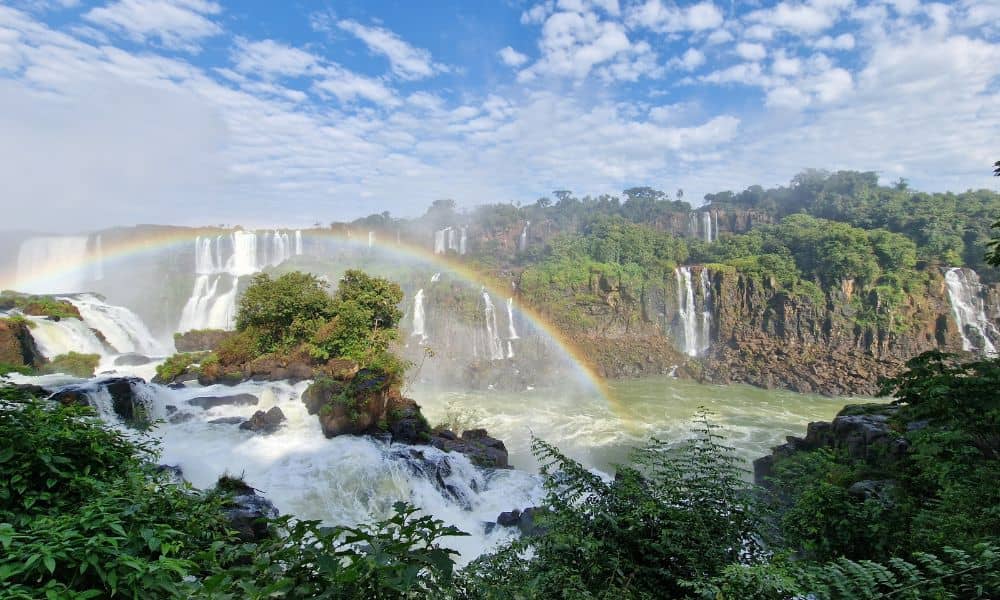
The best time to visit Iguazu Falls
As a family, we love to explore the world’s wonders and have learnt that one of the keys to a truly unforgettable experience lies in choosing the perfect time to visit. This is especially true in parts of the world where seasons can vary dramatically.
Ultimately, the best time to visit will depend on your preferences and the overall itinerary of your trip. What is best for one is not necessarily best for all.
Best Months to Visit Iguazu Falls
April and May mark the start of winter and Brazil’s ‘dry season’. This is a great time to visit Iguazu, with manageable temperatures, reduced humidity, dry weather and fewer crowds (except Easter).
June, July and August are busier due to coinciding with seasonal vacations. We visited both sides of Iguazu Falls in July, and whilst it was busy, there was still plenty of space on the boardwalks, and the parks never felt crowded. The temperature was perfect for us, with low humidity, lots of wildlife and stunning scenery.
September and October are also good times to visit, but the falls look different, with less water flowing towards the end of winter. You’ll see more rocks exposed under the falls and will likely see more wildlife in the forest.
Summer runs from November through to March, bringing the tropical wet season and high temperatures. It is a popular time to visit as the falls are at their fullest, and for those wanting maximum flow, this is the best time to visit.
Best Time Of Day To Visit Iguazu Falls
Opening hours: Argentinian side 0800-1700 & Brazilian side 0900-1800
The best time of day to witness the awe-inspiring beauty of Iguazu Falls is typically in the morning. Here’s why:
While mornings are generally recommended, Iguazu Falls is a stunning sight at any time of day. If you have the opportunity, consider experiencing the falls in the morning and later in the day to witness the changing moods and lighting conditions.
When To Avoid Visiting Iguazu Falls
While Iguazu Falls is a breathtaking and popular tourist destination, there are times when you might consider avoiding a visit to ensure a more enjoyable experience.
The peak rainy season (January and February) can bring challenges. Heavy rainfall can lead to muddy and slippery trails, making it difficult to explore the area comfortably.
High water levels can be an awe-inspiring time to visit Iguazu Falls, but during increased rainfall, there can be unexpected closures of some trails and viewpoints for safety reasons.
Like many tourist destinations, Iguazu Falls can get crowded during major holidays (Summer and winter vacation periods, Semana Santa) and weekends. If you prefer a quieter experience and want to avoid long lines, consider visiting on weekdays or during non-holiday periods.
The region can occasionally experience extreme weather, including severe storms and flooding. It’s advisable to check weather forecasts and the local conditions before planning your trip to ensure safety and avoid travel disruptions.
Iguazu Falls is situated in tropical rainforest, and there can be periods of high mosquito activity. It’s essential to bring insect repellent and take appropriate precautions, especially during the wetter month.
Tour groups arrive and depart two hours after opening and before closing. For reduced crowds, arrive early.
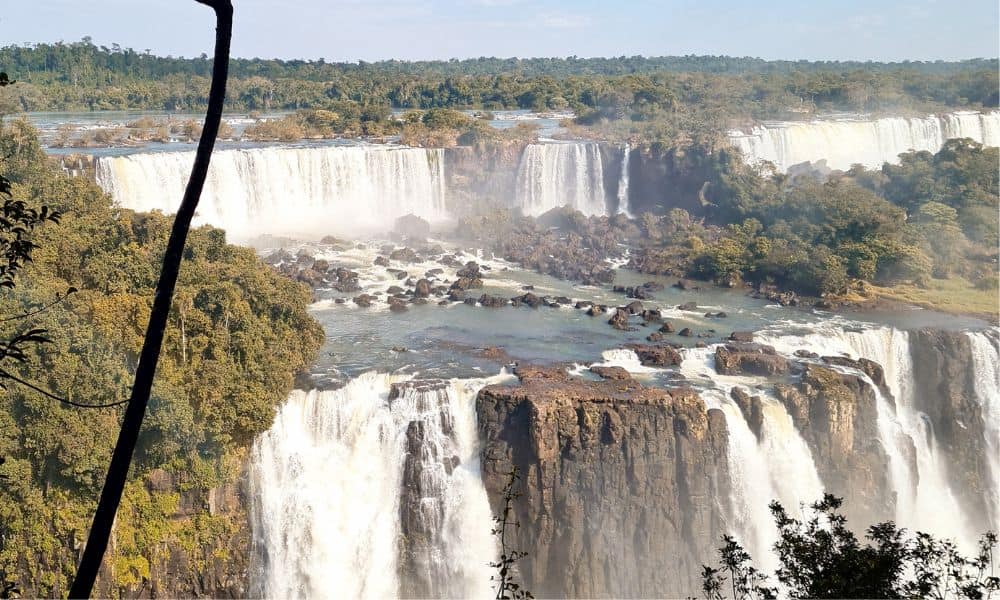
Which Season To Visit Iguazu Falls?
Iguazu Falls can be enjoyed year-round and experience two main seasons: Summer (wet season) and Winter (dry season). The weather may vary dramatically even within each of the seasons and can impact the water levels and overall experience for visitors
Visiting Iguazu Falls in Summer (October to March)
If you’re looking for the classic postcard-perfect view of Iguazu Falls with roaring waters and lush green surroundings, the high season might be the best time for your family trip. This period spans from October to March, coinciding with the South American summer, and offers warm temperatures and increased rainfall.
Here’s what you can expect during the high season:
- Lush greenery: The rainforests surrounding the falls are at their most vibrant during this time, creating a stunning backdrop for your family photos.
- Warmer weather: With temperatures ranging from 25°C to 35°C (77°F to 95°F), it’s a great time to enjoy the trails and outdoor activities with your family.
- More water: The falls are most impressive, with the highest water levels during these months.
Visiting Iguazu Falls In Winter (April to September)
For families who prefer cooler weather and fewer crowds, the winter season, spanning from April to September, can be an excellent choice. This period aligns with the South American winter and offers a different but equally enchanting experience. Here’s what to expect:
- Milder temperatures: During these months, temperatures range from 15°C to 25°C (59°F to 77°F), making it a comfortable time for outdoor exploration.
- Fewer tourists: With less foot traffic, you and your family can enjoy a more peaceful and intimate experience at the falls.
- Opportunity for wildlife: The reduced foliage can make spotting various bird species and other wildlife in the surrounding rainforest easier.
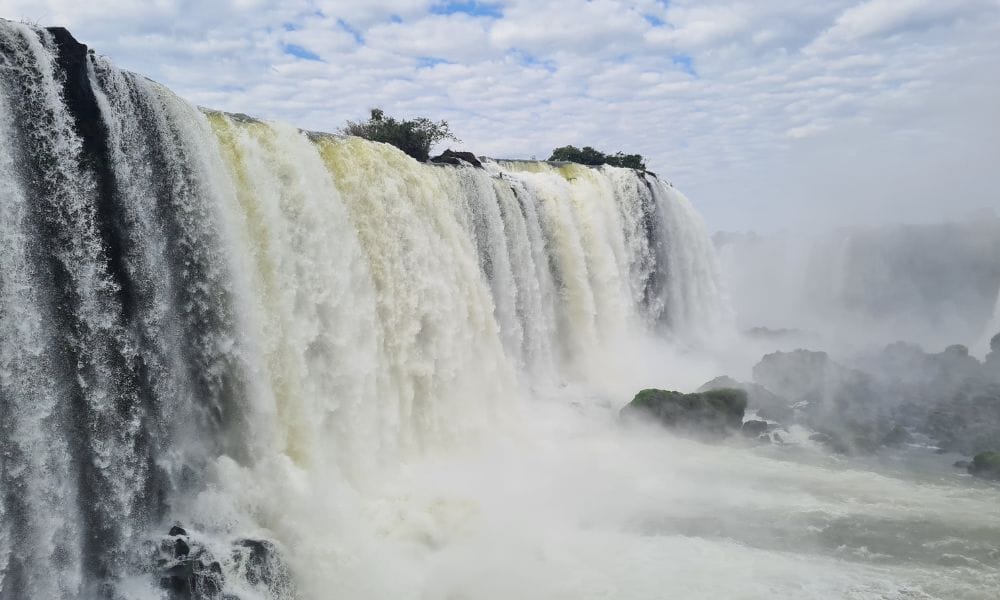
Our experience of visiting Iguazu Falls
We visited Iguazu Falls in July at the start of our family gap year.
This family adventure was a dream come true for us. The anticipation of witnessing one of nature’s most spectacular wonders was the reason it was one of the first items added to our agenda. Little did we know that our experience would be enriched by the unique perspectives offered by both the Brazilian and Argentinian sides of the falls.
Visiting Brazilian Iguazu Falls
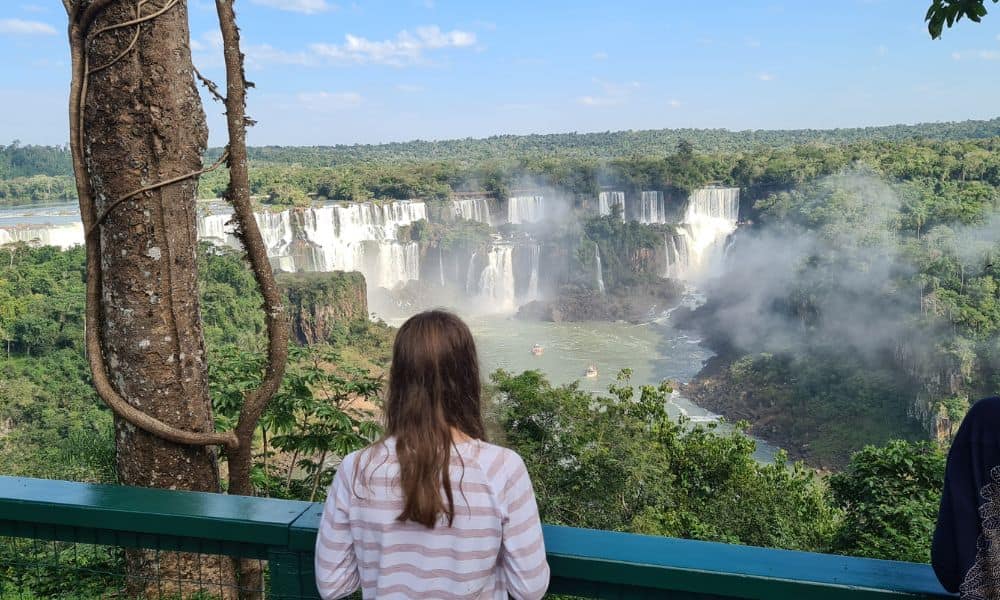
We visited the Brazilian side of the Iguazu Falls first and the panoramic views from the walkways provided a breathtaking introduction to their grandeur. Watching the water thundering down was mesmerizing, and we also got soaked, much to the kids’ delight, as we stood at the curtain of the Devil’s Throat. Here are some of the highlights from our time on the Brazilian side:
- Iconic Views: Stunning panoramic views of the falls allow a deeper appreciation of the vastness of this natural marvel.
- Devil’s Throat: The highlight of our Brazilian experience was undoubtedly the awe-inspiring water crashing down and the mist rising at the Devil’s Throat.
- Bird’s-Eye Perspective: The elevated walkways provided a unique bird’s-eye perspective, allowing us to see the intricate patterns formed by the cascading water and the lush surrounding rainforest.
visiting Argentinian Iguazu Falls
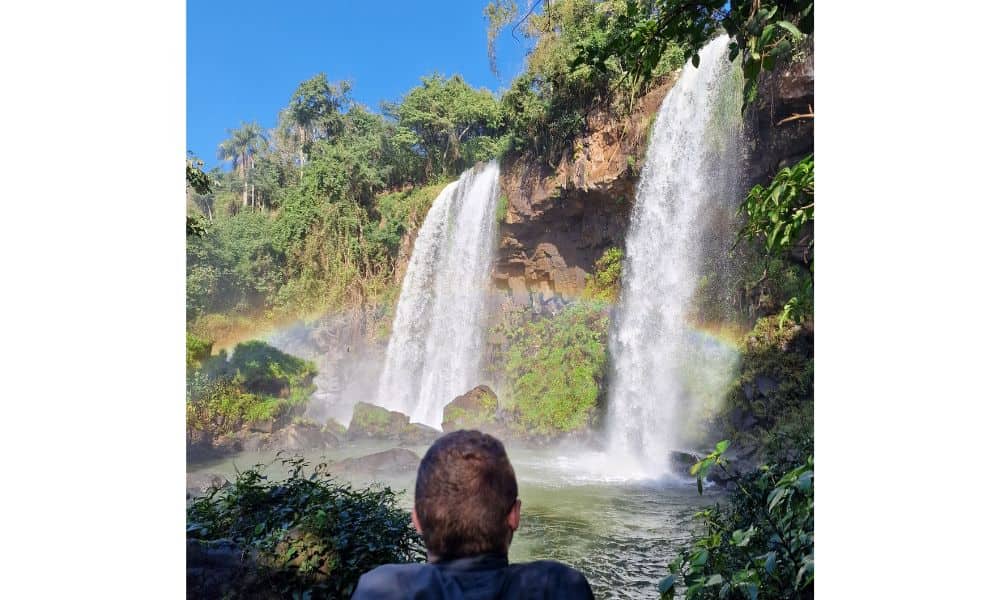
For our second day, we crossed over to the Argentinian side, bringing us closer to the falls and immersing us in the heart of Iguazu’s beauty. A train took us deeper into the park. The Argentinian experience gave a different dimension to our journey that was not in our original plan but was a welcomed addition.
- Up-Close Encounters: The network of trails on the Argentinian side allowed us to get up close and personal with the falls. The Lower and Upper Circuits provided different vantage points, each revealing the beauty of the falls in a new light.
- Boat Adventure: Our family’s sense of adventure reached new heights with a boat ride to the base of the falls. The thrill of feeling the spray on our faces and the sheer power of the water made this experience a highlight for us and the kids.
- Flora and Fauna: The Argentinian side allowed us to get closer to and spend more time exploring the surrounding flora and fauna. We encountered colourful butterflies, diverse bird species, huge spiders, Coati, Caiman and the vibrant energy of the rainforest.
If you’re planning a family trip to Iguazu Falls, we highly recommend exploring both sides to appreciate this natural wonder’s grandeur and diversity fully. A boat tour close to the falls is a definite must for adventure seekers! It’s a journey that will forever hold a special place in our family’s travel memories.
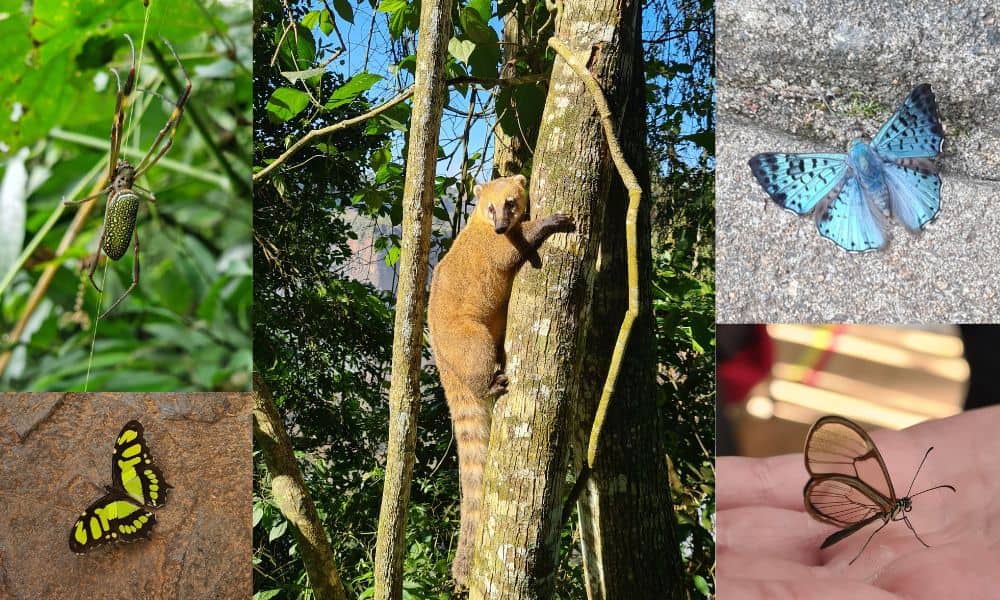
Considerations for Visiting Iguazu Falls
Preparing for any eventuality, especially when travelling with kids, is tough. Here are a few essentials to consider for your visit.
- Rain gear: Regardless of the season, you’ll likely encounter mist and rain near the falls. Be prepared with waterproof jackets and bag covers to protect your belongings.
- Comfortable shoes: Choose sturdy, comfortable shoes for exploring the extensive trail system around the falls. Be prepared for kids to get tired!
- Stay hydrated: With the tropical climate, drinking plenty of water is essential, especially during the high season.
- Snacks: The trails may feel longer than they are when walking in the South American heat. Although there are places to purchase food and drink, they are expensive, so having some with you may save you some cash.
- Coatis: They may look cute but have little fear of humans. They can become aggressive if they think you have food and may bite.
Visiting Iguazu Falls: FAQ
There are always more questions to ask. Here are a few frequently asked ones about Iguazu Falls:
Is Iguazu Falls the largest waterfall in the world?
The Iguazu Falls are the largest waterfall system in the world but are neither the widest nor the highest! This apparent anomaly is down to how you define ‘largest’ and is worked out using a combined calculation of width, height and flow.
Whilst there may be higher waterfalls and there may be wider waterfalls, there are no waterfalls that are both wider and higher!
What is the best time of day to visit Iguazu Falls?
The best time of day to witness the awe-inspiring beauty of Iguazu Falls is typically in the morning. You get optimal light, fewer crowds, cooler temperatures and more active wildlife.
Iguazu Falls is a stunning sight at any time of day and ultimately, you should time your trip to suit your preferences and itinerary. If you have the opportunity, consider experiencing the falls in the morning and then again later in the day to witness the changing moods and lighting conditions.
Is Iguazu Falls open all year?
Iguazu Falls is open to visitors throughout the year. The falls are a year-round attraction, offering a unique experience each season.
Before planning your trip, you should check for any maintenance or temporary closures affecting specific trails or viewpoints. Additionally, watching weather conditions can help you prepare for a comfortable and enjoyable visit.
How long does it take to explore Iguazu Falls?
The time it takes to explore Iguazu Falls can vary based on various factors, including the activities you choose to engage in, the trails you want to explore, and whether you visit the Brazilian or Argentinian side. To fully explore the falls, we highly recommend taking a boat trip, which can be arranged in either park.
The full Brazilian walkway is relatively short and possible to complete in half a day, whereas the Argentinean side has an extensive trail system and can take a full day to explore.
Final thoughts: the best time to visit Iguazu Falls
Visiting Iguazu Falls is a magical experience for families at any time of the year. The best time to visit really does depend on your preference and availability to travel. If you are lucky enough to have a choice of when to go, late April and May have large volumes of water flowing, fewer crowds and good weather; September and October are a very close second.
A journey around the Iguazu Falls, spanning the Brazilian and Argentinian sides, is an unparalleled adventure. Both perspectives, whether from the expansive viewpoints in Brazil or the intimate trails in Argentina, are stunning in their own right and combined to form a complete picture that will stay with you forever.
Whether you opt for the high season’s lush greenery or the quieter months of the shoulder seasons, one thing is certain – the awe-inspiring beauty of Iguazu Falls will create cherished, lifelong memories for you and your family.
